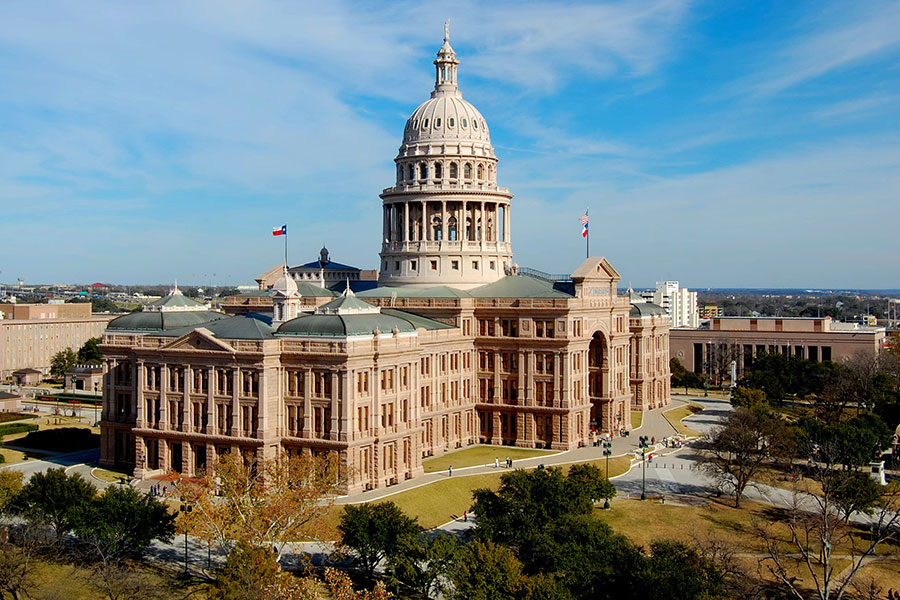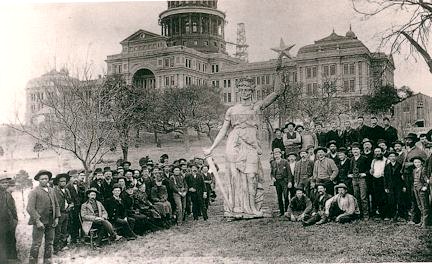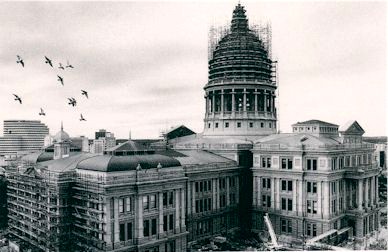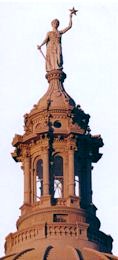"Texas stands peerless amid the mighty, and her brow is crowned with bewildering magnificence! This building fires the heart and excites reflection in the minds of all."
Senator Temple Houston, youngest son of Sam Houston, on the
occasion of accepting the new Capitol building on behalf of the people
of Texas.
May 16, 1888.
For excerpts of this speech click here


The Texas Capitol, which stands majestically before us today, is the design of Elijah E. Myers, who won the nationwide design competition for the project in 1881. Mr. Myers, who also designed the Michigan and Colorado Capitols, was paid $1,700 for the initial plan. The Capitol he designed replaced the first, rather plain limestone structure which had been built on the site in 1853. The 1853 Capitol burned to the ground in a dramatic fire as plans were underway for the grand new Capitol.
The Texas Legislature, in drafting the new State constitution in 1875, had set aside three million acres of public land in the Panhandle of Texas to fund the new Capitol. A syndicate based in Chicago was formed to build the Capitol and to develop the Panhandle lands that were given in exchange. This acreage would become the famous XIT Ranch, portions of which the syndicate began selling in 1901.
When the Capitol opened to the public on San Jacinto Day, April 21, 1888, the departments of government were housed in the building, including the State Treasury, Comptroller, Agricultural Department, Geological Department, Department of Education, Capitol Police, Adjutant Generals Department, Attorney General, Appellate Court, Supreme Court, and State Library. The new building was grand in its vision and design, but it was also capable of supporting the governmental functions at the time.
Construction on the Texas Capitol began in February 1882. Capitol Architect E.E. Myers had agreed to several design changes, notably a switch from a square tower with a Mansard roof to a cast-iron dome similar to the dome on the National Capitol, which had been completed in the 1860's. The State had specified a fireproof building, which in the late 19th century usually meant a wrought iron or cast iron structural system covered in masonry Myers specified limestone or sandstone for the exterior of the building, as the State wanted as much of the material as possible to come from Texas. When the limestone selected from a quarry southwest of Austin was found to discolor easily, the decision was made to use "sunset red' granite from what is now Marble Falls, Texas. Myers had to simplify many of the original details of his Renaissance Revival design since the softer limestone would have been easier to carve. Contractor Gus Wilke was eventually forced to import stonecutters from Scotland to cut and set the granite when a labor dispute arose.

The Texas Capitol is an impressive building by any measure. When the 360,000 square foot building was completed in 1888, it was claimed to be the seventh largest building in the world. Some 1,000 men worked every day for four years at the height of the project. The product of their labor stood 311 feet tall from the ground to the toes of the Goddess of Liberty, covered 2 1/4 acres, contained 392 rooms, 18 vaults, 924 windows, 404 doors, 4,000 railroad cars of granite, 11,000 railroad cars of limestone and other materials, and cost $3,744,600 to build. it was also said to be taller than the National Capitol, although a carefully measured comparison has yet to be made.
When the Capitol opened to the public on San Jacinto Day, April 21, 1888, the departments of government were housed in the building, including the State Treasury, Comptroller, Agricultural Department, Geological Department, Department of Education, Capitol Police, Adjutant Generals Department, Attorney General, Appellate Court, Supreme Court, and State Library. The new building was grand in its vision and design, but it was also capable of supporting the governmental functions at the time.
